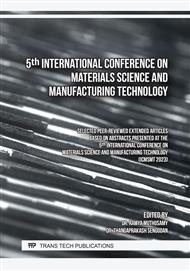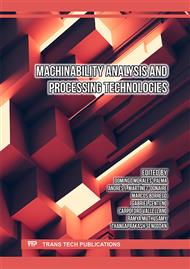[1]
Ravikumar D Patel, Sanket N Bhavsar, Experimental investigation during end milling of AISI D2 tool steel using AlCrN coated tool, Materials Today, 2020, pp.2648-2657
DOI: 10.1016/j.matpr.2020.03.396
Google Scholar
[2]
K R Aharwal, Sitaram, C M Krishna, Optimization of Material Removal Rate and Surface Roughness in EDM Machining of Metal Matrix Composite using Genetic Algorithm, materials today, Volume 5, issue 2, Part 1, 2018, pp.5391-5397
DOI: 10.1016/j.matpr.2017.12.125
Google Scholar
[3]
J B Saedon, S L Soo, D K Aspinwall, A Barnacle NHS, Prediction and Optimization of Tool Life in Micromilling AISI D2 ( ~ 62 HRC ) Hardened Steel, Procedia Eng. 2012;41:1674-1683
DOI: 10.1016/j.proeng.2012.07.367
Google Scholar
[4]
Lincoln Cardoso Brandão, Reginaldo Teixeira Coelho ARR, Experimental and theoretical study of workpiece temperature when end milling hardened steels using (TiAl)N-coated and PcBN-tipped tools, J Mater Process Technol. 2008;199(1):234-244
DOI: 10.1016/j.jmatprotec.2007.07.049
Google Scholar
[5]
Marton Takacs BZF. Hard Cutting of AISI D2 Steel. 3rd Int Conf Mech Eng Mechatronics. 2014;(176):1-7.
Google Scholar
[6]
Ravikumar D Patel, Sanket N Bhavsar, Optimization of Machining Parameters to Minimize Surface Roughness During End Milling of AISI D2 Tool Steel Using Genetic Algorithm, Proceedings of ICAMME 2019, Advances in Materials and Manufacturing Engineering, Lecture Notes in Mechanical Engineering (LNME), January 2020, Pages 231-238
DOI: 10.1007/978-981-15-1307-7_25
Google Scholar
[7]
Vinayak Neelakanth Gaitonde SRK, Maciel CHA, Rubio JCC, Abrão AM. Machinability Evaluation in Hard Milling of AISI D2 Steel. Mater Res. 2016;19(2):360-369
DOI: 10.1590/1980-5373-mr-2015-0263
Google Scholar
[8]
Ravikumar D Patel, Sanket Bhavsar, Optimisation of machining parameters on cutting force during end milling of AISI D2 tool steel using Genetic Algorithm, Industrial Engineering Journal, Ivy Scientific, Volume 13, Issue 4 April 2020
DOI: 10.26488/IEJ.13.4.1237
Google Scholar
[9]
Saedon JB, Soo SL, Aspinwall DK, Barnacle A, Saad NH. Prediction and optimization of tool life in micromilling AISI D2 (∼62 HRC) hardened steel. Procedia Eng. 2012;41(Iris):1674-1683
DOI: 10.1016/j.proeng.2012.07.367
Google Scholar
[10]
Ravikumar D Patel, Sanket N Bhavsar, Experimental investigation during end milling of AISI D2 tool steel using AlCrN coated tool, Materials Today, 2020, pp.2648-2657
DOI: 10.1016/j.matpr.2020.03.396
Google Scholar



